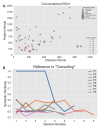Feasibility Analysis of Phenotype Quantification from Unstructured Clinical Interactions
- PMID: 38774775
- PMCID: PMC11104416
- DOI: 10.5334/cpsy.78
Feasibility Analysis of Phenotype Quantification from Unstructured Clinical Interactions
Abstract
We conducted a feasibility analysis to determine the quality of data that could be collected ambiently during routine clinical conversations. We used inexpensive, consumer-grade hardware to record unstructured dialogue and open-source software tools to quantify and model face, voice (acoustic and language) and movement features. We used an external validation set to perform proof-of-concept predictive analyses and show that clinically relevant measures can be produced without a restrictive protocol.
Keywords: acoustic; conversation; digital phenotype; facial feature; voice.
Copyright: © 2022 The Author(s).
Conflict of interest statement
The authors have no competing interests to declare.
Figures


References
-
- Baltrusaitis, T., Zadeh, A., Lim, Y. C., & Morency, L.-P. (2018). OpenFace 2.0: Facial Behavior Analysis Toolkit. 2018 13th Ieee Int Conf Automatic Face Gesture Recognit Fg 2018, 59–66. DOI: 10.1109/FG.2018.00019 - DOI
-
- Bishay, M., Palasek, P., Priebe, S., & Patras, I. (2019). SchiNet: Automatic Estimation of Symptoms of Schizophrenia from Facial Behaviour Analysis. Ieee T Affect Comput, 1–1.
LinkOut - more resources
Full Text Sources

